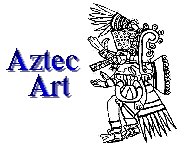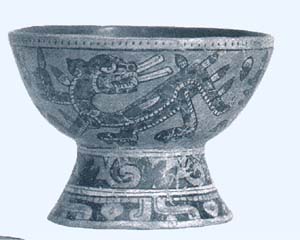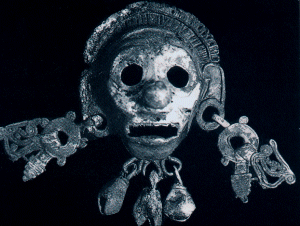
Stoneworking
The working of stone was principally used in the making of jewelry. Obsidian was always ranked as one of the most useful stones. During the early centuries, Teotihuacan had controlled the prime sources of this valuable material and traded obsidian as far south as Guatemala. Razor-like blades were flaked off larger blanks of the stone in a sophisticated "unwrapping" process; single-edged and double-edged knives were also made, as were scrapers, v-shaped gougers, dartpoints of various dimensions, and heavy striking blades.
Aztec craftsmen were employed by the state to make colossal basalt sculptures. They acquired the tradition of monumental stone carving first from Atzcapotzalco, and later from the Huaxtecs of the Gulf Coast. Their ability to develop their own expressive style is evident when we compare the primitive sculptural forms and Itzcoatl's pyramid, dating to about 1430, with monuments made between the 1450s and early 16th century.
Basket-making
Like methods of making stone tools, basketry had been a feature of hunting and gathering cultures. A the market in Tenochtitlan, baskets of many sizes and shapes were used and sold, for carrying produce, storing grains, and as special containers designed for different foods. Fine baskets of very tight weave were intended for personal use, holding valuables such as jewelry or family keepsakes. Larger square or rectangular baskets with lids were used as chests for clothing. Closely related to the basketmakers were the weavers of reed mats (petlatl) and the makers of reed seats.
Textiles
At Tenochtitlan, sumptuary laws were enforced to regulate the wearing of clothes according to social and official position. Most commonly, cloth was made of maguey or henequen fiber for capes, loincloths, skirts, and huipiles. Cotton had long been cultivated in Mesoamerica, and was raised in warm lowland Morelos since the time of Teotihuacan. Aztec men and women wore the same styles of garments as the lower orders. There were no tradition of tailoring clothes to fit the limbs and body. Dyes were made of mineral sources such as blue clay and yellow ocher, and vegetal dyes were derived from a multitude of plants. Red color was obtained from cochineal insects, which were raised in nopal cactus groves, and violet was obtained by dyeing skeins of cotton thread with a section from coastal mollusks.
Feather garments were a specialty of weavers called amanteca, whose brilliant products were reserved for the nobility and the highest-ranking officials. Feathers for these most prized garments were gathered by professional hunters who netted birds in the tropical forests, but colorful plumage could also be obtained from birds raised in captivity. Several Aztec ceremonial shields have survived which demonstrate the bold effects achieved by these artisans, who were not only superb technicians but also unsurpassed colorists and designers.
Ceramics
One of the most extensive sections of the Tlateloco market was assigned to the pottery-sellers. Pottery began on ancient Mexico with the appearance of village agricultural life, and like others before them the Aztecs had their own styles of ceramics. Aztec potters favored more naturalistic motifs, depicting flowers, fish and other animals in combination with finlike designs. Aztec potters also made special wares for their temples, sometimes using techniques and shapes that followed earlier ceramic traditions.
Jewelry and Metallurgy
The golden ornaments worn by Aztec officials and nobles were made by Mixtec craftsmen working in Tenochtitlan. The tradition they brought with them had been developing in their Oaxacan homeland sice about the 10th century ad. In Mexico the earliest and most developed metalworking centers were on the Pacific side. The Tarascan people of Michoacan developed a copper-working industry that included such trade items as cast bell for wear on dance costumes, tweezers, needles, copper axes, and small figurines. Yet the Mixtecs of Oaxaca remained the most celebrated artisans, and it was though them that the art of jewelry was brought to Tenochtitlan. Gold was panned and collected as nuggets from riverbeds, and melted in furnaces heated by men blowing through tubes onto charcoal embers.

Ceramic Bowl

Aztec Jewelry